 I’m Happy to post a link to my article in Voices, the Journal of the New York Folklore Society: http://www.nyfolklore.org/pubs/v43fw3-4-2017/10-fw2017-kennedy-1.html
I’m Happy to post a link to my article in Voices, the Journal of the New York Folklore Society: http://www.nyfolklore.org/pubs/v43fw3-4-2017/10-fw2017-kennedy-1.html
The PDF of the article can also be downloaded here: Fruit In the Forest
 I’m Happy to post a link to my article in Voices, the Journal of the New York Folklore Society: http://www.nyfolklore.org/pubs/v43fw3-4-2017/10-fw2017-kennedy-1.html
I’m Happy to post a link to my article in Voices, the Journal of the New York Folklore Society: http://www.nyfolklore.org/pubs/v43fw3-4-2017/10-fw2017-kennedy-1.html
The PDF of the article can also be downloaded here: Fruit In the Forest
While researching cider in the Finger Lakes region, I stumbled into an amazing resource, the New York State Historic Newspapers website. Search for cider, and it begins to pop up all over the place. I will be sharing some gems periodically to show how cider played a part in the everyday lives of people living in the southern Finger Lakes.

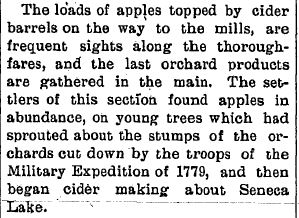
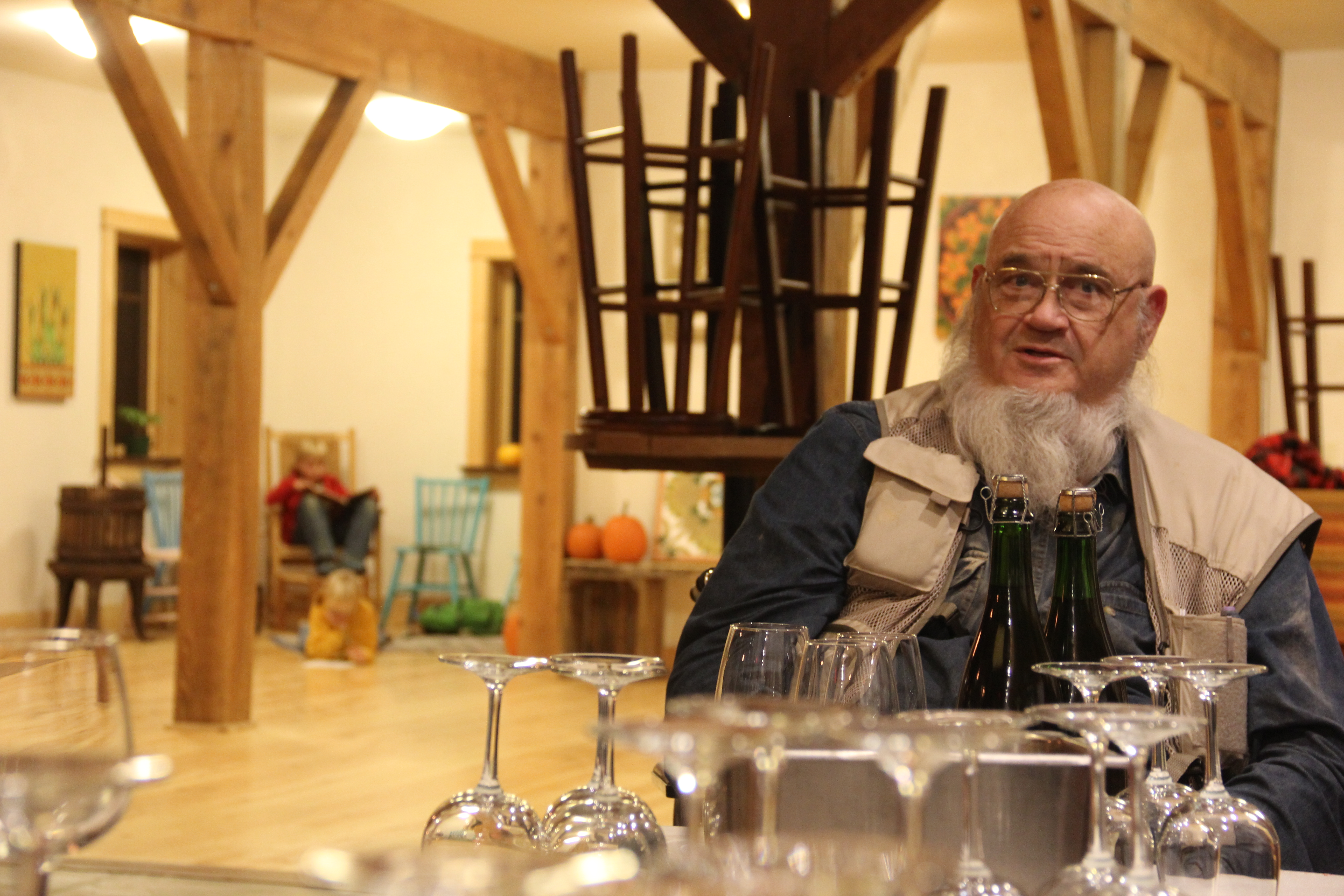
The Finger Lakes Cider House is usually full of customers tasting during the weekend. But on a dark Tuesday night in November, a group of local cider makers gathered there around a long table to taste a collection of ciders from West County Ciders in Shelburne Falls, Massachusetts. Hosted by home cider maker Peter Hoover, the tasting consisted of 15 ciders from West County, many purchased by Peter at a recent sell-off of their older vintages. The tasting was a unique opportunity to taste some older vintages and ponder how the different varieties held up over time. It was also a wonderful experience to taste so many ciders by a single producer and to notice similar taste notes throughout.
But in addition to thinking about the ciders themselves, I’ve also been thinking on how and why sensory learning happens, and how differently the sense of taste is experienced by different individuals.
There are a variety of wonderful blogs devoted to assessing the taste of ciders . These do a great service to the industry, but it has never been my intention in this blog to review ciders (see the links page for some suggestions on blogs that do this well and consistently). I’m interested, however, in the ways that a “review” of a cider is a distillation of a social experience: trying to communicate a most ephemeral personal sensation that may be widely differentiated in quality and character between individuals. We don’t all taste in the same way. How can we talk about it? It’s one reason that social tastings like these are crucial to the education of a cider maker. Discussion of taste is key. It’s not just that one’s taste experience can be influenced by suggestion, or that one can become proficient, honing the sense with practice (though this is true). More than that, other people may be more sensitive to something you are less able to experience. They may highlight tastes or smells you might disregard or pass over. Sometimes, to taste is to listen.
I’ll be the first to admit that I find tasting difficult not only to explain, but even to experience consciously. Learning to taste is a process that often seems to slip through whatever neurons fire between tongue and brain, difficult to pinpoint in the transfer, because it is less on the tongue than in the mind, and usually trapped inside another memory. It is a very delicate and fragile construction of sensory associations, one that must be rebuilt to consider each new drink, isolating the sensations, repeating them often enough to recognize distinct notes.
However, I tend think more in constellations of associations, rather than isolations of sensation. Often, a taste takes me back to moment where I experienced that sense before. Recently a friend handed me a liqueur, and I said: it tastes like the library. I can pick out the individual notes (leather, lemon, liquorice) that define that smell, but the library is a more interesting descriptor for me, personally. I think of my favourite library, the Birks Religious Studies Library at McGill University, where the bearded librarian sewed bookbindings behind his desk, everyone left their shoes at the door to preserve the delicate parquet wood floor, and the desk lamps became little islands of soft light in the early dark of Montreal winter.
Sometimes, a taste does not register for me at all. Saffron, exquisite and expensive as it is, does not induce any sensation for me. I am dependent on the descriptions of my friend to appreciate its wonders. It makes me appreciate how much I need to cultivate other people, and other experiences, to experience taste.
I’ve sat around many barns and cellars and conferences while people taste ciders and wines and beers and let taste descriptions roll of their tongues in equal measure to the beverages rolling in. The degree to which people can disagree on taste is perhaps one of the social blessings built into the enjoyment of craft beverages, for it allows people to talk longer, enjoy each other’s company more (one hopes). It generally extends the occasion of drinking by at least a factor of three and allows all kinds of other nuggets of information to emerge: such as the fact that Tremletts Bitter in America is not the same as the variety in England. Ian Merwin explained this to us as we sipped the West County Tremletts, that the resident tree at the Geneva station must have been misidentified at some early stage, the error only recognized years later by a visiting scientist from Bulmers.
Tasting is never just about tasting, really. And while a descriptive analysis of cider is always useful, especially for the gastronome, the ways in which it the experience of taste are tied to memory, physiology, sociability, and other kinds of knowledge, make it far more complex than a list of tasting notes could ever describe.
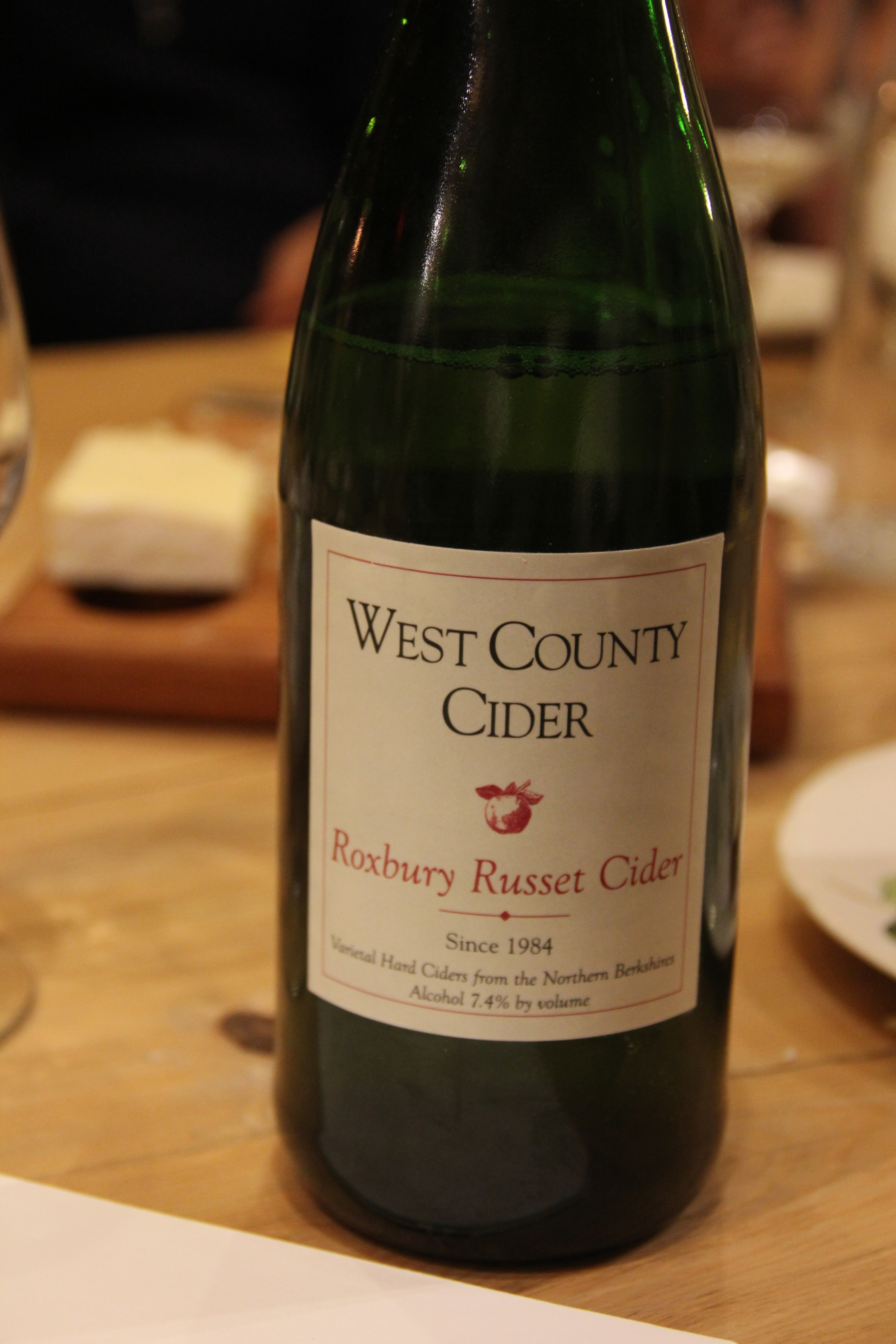
At the tasting of West County ciders, there were certainly many points of departure in describing the tastes, though almost everyone settled in some agreement on the favourite of the night: A Roxbury Russet cider with a blend of 25% Golden Russet, 25% Esopus Spitzenburg, and 50% Roxbury Russet. In addition, several people noted an overall caramel flavour that pervaded several of the ciders, with speculation that it could be either the result of pasteurization or oxidation. Though few of the sparkling ciders had maintained much fizz, there were several of the older bottles with a surprising freshness and brightness of taste.
The following is the List of Ciders we tasted, with cursory notes that reflect a mixture of my own and other people’s comments (though I didn’t record all comments). Dates and blends were not known for all ciders.
But most importantly, the company was excellent, there was much cheese, I learned quite a bit about these apples, and I listened with abandon to the tastes everyone else was experiencing.
The West County Ciders
– Maria Kennedy, with thanks to Peter Hoover for the invitation and some editorial additions.
Some snaps from an afternoon at the Finger Lakes Cider House during Cider Week Finger Lakes back in October. Some pressing demonstrations, games, gorgeous weather, and lazing in the lingering autumn sun.
Cider Week Finger Lakes was a smash! And our cup runneth over with events. To start off this Cider Week, I went to two different apple festivals, one connected to Cider Week, and the other not.
On Friday afternoon on the first weekend of October, I left work early and headed for the Ithaca Apple Festival. In its 33rd year, the Ithaca Apple Festival had been, until recently I am told, bereft of much connection to apples. But with the advent of Cider Week Finger Lakes, the cider makers are now a big presence at the Apple Festival, which acts as a kick-off for the region’s Cider Week.
Walking down State Street, I could see all the trappings of a street fair calling – some small scale carnival rides, the twirling teacups, a carousel, two gourmet mac and cheese food trucks, a Columbian street food vendor. A skinny bearded young guy pulled a cart collecting compost. A tired carney checked his cell phone. College kids took selfies with their steaming cups of cider, and an old man in overalls stood behind an unglamorous but bountiful stall of vegetables. Two ladies sat beside a community quilt, selling tickets to raffle it off. A corridor of handmade jewellery and brooms and aprons funneled the crowd crossways.
A steady stream of young professionals and grad students rotated in and out of the Cellar d’Or Wine and Cider Shop, queuing up to taste and take with cider makers from Black Diamond Farm, Redbyrd Cider, South Hill Cider, and Eve’s Cidery, who stood with steady arms and long patience beside their barrels and bottles.
Outside, on the commons, the ciders and the wineries, the soup seller, and the orchards and apple vendors, all made the most of the festival theme. Fresh apples, apple soup, hot cider, hard cider, sweet cider, dry cider, turnovers from Indian Creek Orchard, and doughnuts from Little tree orchard – and a line 20 feet long to get them. The horticulture students hawked the fruits of Cornell’s research orchards.
The next day, I headed out to the Newark Valley Historical Society Apple Festival, an event in its 36th year, with no connection to Cider Week Finger Lakes. The weather had turned grey and misty and cold, but I got in my car and drove east on 79 out of Ithaca, turning south down 38, into hills and valleys. Route 38 is an old turnpike, and you can see the age of the road by its early farmhouses. As I approached the Newark Valley Historical Society Apple Festival, a sign warned cars to slow down, and pumpkins lined the road where policemen directed traffic into the adjacent field.
The small living history museum was filled for the day with demonstrators and vendors of historical, traditional, and rural arts. An enormous iron kettle filled with salt potatoes was boiling in the midst of the tents, and under two tall old trees, a mobile cider mill was hissing, spitting, grinding, and pressing.
Asking about the mill, I fell into conversation with the husband and wife operating it, who then introduced me to its builder, C.O. Smith, aged 92. Mr. Smith shook my hand and told me that the engine on the mill was over 105 years old, and that he had built the machine to replicate one that his grandfather had used on their farm south of Rochester. It was built for the festival, which he and others had started as a way to raise funds for the Historical Society.
I wandered through the festival and spoke to woodcarvers from the Catatonk Valley Woodcarver’s group, to a luthier who builds dulcimers in traditional and avant garde designs, and to a beekeeper whose honeys were made of nectars as varied as the apple blossoms of spring to the invasive Japanese knotweed that chokes the landscape and blooms profusely in late summer.
These two apple festivals, happening simultaneously and within 40 miles of each other, and yet in some ways worlds apart, show different sides of the region’s apple culture, speaking to different audiences, in different communities. The Ithaca festival is more obviously commercial, and the Newark Valley festival skews more historical and educational. While preserving the uniqueness of each festival and the communities they serve, it would be interesting to see what could happen if the commercial and the educational missions of each festival could enliven and enrich each other.
How much more rooted can commerce be if it can draw on a region’s historical identity? How much more present and emergent can history be if it is a living resource for the new commercial enterprises that Cider Week Finger Lakes seeks to promote? There are more apple festivals to visit, and an exciting possible future for the relationship of Cider Week Finger Lakes to long-running community celebrations.
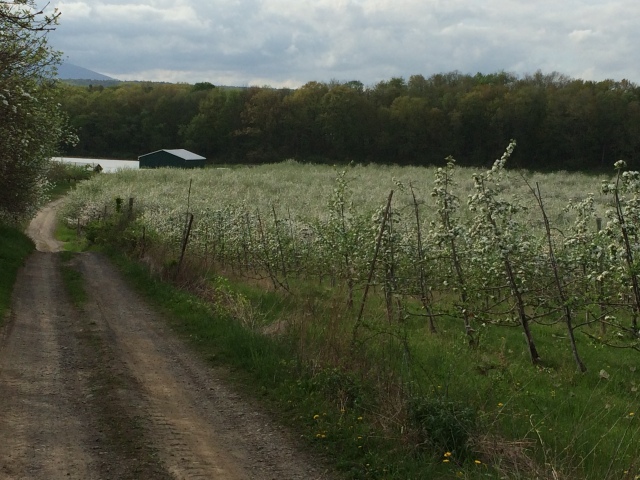 The blossoms have come and are now almost gone here in upstate New York. Since I last posted, nigh eons ago, I’ve relocated from Indiana to the Finger Lakes region of New York to start a new job. It’s been a big change, but an exciting one, with so much more cider now close at hand!
The blossoms have come and are now almost gone here in upstate New York. Since I last posted, nigh eons ago, I’ve relocated from Indiana to the Finger Lakes region of New York to start a new job. It’s been a big change, but an exciting one, with so much more cider now close at hand!
I said a dewy-eyed farewell to Oliver Winery and the Creekbend Vineyard in Indiana, where I had the privilege to work alongside some fantastic people, learn a  little bit about viticulture, and become familiar with the dips and crests of the rolling landscape of the vineyard, and the personalities of each field. There were wet spots filled with mosquitos, the acres of Chambourcin and Chardonel vines devastated by the polar vortex, the finicky short rows of pampered vinifera, the acres and acres of hardy Catawba, and the bowl of land left over to wildflowers that drained into a stream leading into the woods.
little bit about viticulture, and become familiar with the dips and crests of the rolling landscape of the vineyard, and the personalities of each field. There were wet spots filled with mosquitos, the acres of Chambourcin and Chardonel vines devastated by the polar vortex, the finicky short rows of pampered vinifera, the acres and acres of hardy Catawba, and the bowl of land left over to wildflowers that drained into a stream leading into the woods.
Here in New York, I have much to learn about the local climate and its effect on apple and grape cultivation. The cider industry is young and exciting, with the Finger Lakes Cider House opening just last week. It seems like I learn about a new cidery every time I turn my head.
I look forward to turning this blog in the direction of more sustained writing about fruit, fermentation, and landscape in my new home. And I’m not alone! I’ve been delighted to be warmly welcomed by Meredith, author of the blog Along Came A Cider. And I have recently discovered the the Finger Lakes Apple Tree Project by Steve Selin, maker of South Hill Cider. Cider people are so friendly and welcoming! I’m also really excited about Cider Week Finger Lakes, and I hope to nurture some partnerships in the cider, arts, and heritage communities through my work. There are so many people to meet, ciders to drink, and projects to plan. I am totally the wide eyed new girl on the block, gazing in awe at all the bounty of cider projects around me.
Though New York City is still a good 5 hour drive from these westerly regions of the Great State of New York, I recently managed a trip down thataway and made the pilgrimage to Wassail, the new swanky cider bar in the Lower East Side. That deserves a post all its own, so I’ll return to it later.
But along the way, I ran ( maybe ambled is better) the Hard Cider Run at Warwick Valley Winery, home of Docs Draft Cider, and went for a drive up and down the Hudson Valley, where the orchards were blossoming their hearts out. It’s that ephemeral moment of spring, that you only get to see briefly before the petals fall and the fruit starts to swell in the long balmy stretch of summer ahead. Cideries take note – HUNDREDS of people signed up to run this 5k through the blossom, many of whom may have never thought about cider much before and were clearly just out for a nice day in the country. It was a little chaotic, but everyone seemed to have a great time.
The Blossom Time is the also the time for tree hunters, and I’ve been keeping my eye out as I travel around the highways and byways of my new home territory. I spotted these two ancient orchards during the winter by roadsides in Schuyler County, near the village of Burdette, and Chemung County, near the town of Horseheads. I happened to be driving by them again this weekend, and stopped to see if they had any blossom. They did! But barely. It is easy to see fruit trees young and old blooming near houses, cared for by homeowners. But sprawling old orchards like these are a rare find, as far as I can see, in this part of New York. I still don’t know who owns them, or why they have survived, or what fruit lies in wait there.
There are plenty of old barns slowly rotting away in the countryside here too, as these photos below attest. And plenty of old farmhouses, that look back towards a different farm economy, one that supported relative wealth and vibrant communities in places that are now the back of beyond. Who lived in these enormous old vacant houses? And why do they lie abandoned now? Who planted these old orchards, and what kind of farms are they remnants of?
The new cider industry here is clearly booming. I can’t wait to learn more about the landscapes that supported apples of old, and the new orchards, like these ones at the Good Life Farm, home of the Finger Lakes Cider House, that are rising slowly from the earth to meet a new market, and reshape the land with it.
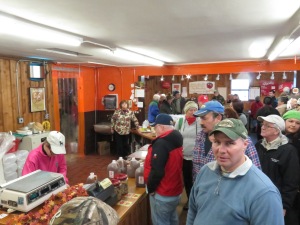 On the day before Thanksgiving, I was driving from Corning, New York to Massena, New York, in order to spend the holiday with my grandmother. Somewhere between Ithaca and Cortland, I made a wrong turn, and I ended up driving through the tiny village of Virgil, no more than a crossroads, where there was an unusual massing of motorists, all turning in at one spot. Naturally, my folklore sense sprung into action, and in a split second, I was turning into this full parking lot to find out what could possibly be motivating everyone else to drive through a harrowing snowstorm to a barn in the middle of nowhere. It turns out, I was at Hollenbeck’s Cider Mill. I end up at Cider Mills even when I’m not looking for them! I swear, it’s a gift, or a Thanksgiving Miracle! When I walked inside, there was a line of people snaking around the rather large interior, past large crates of apples, past displays of maple syrup and cheddar cheese, past the register where several cheerful ladies were writing up orders, and beyond to a room full of cardboard boxes. There were probably upwards of 100 people waiting courteously in line. Are they picking up specially ordered Thanksgiving Turkeys, I wondered? No – they were all waiting in line for apple pie.
On the day before Thanksgiving, I was driving from Corning, New York to Massena, New York, in order to spend the holiday with my grandmother. Somewhere between Ithaca and Cortland, I made a wrong turn, and I ended up driving through the tiny village of Virgil, no more than a crossroads, where there was an unusual massing of motorists, all turning in at one spot. Naturally, my folklore sense sprung into action, and in a split second, I was turning into this full parking lot to find out what could possibly be motivating everyone else to drive through a harrowing snowstorm to a barn in the middle of nowhere. It turns out, I was at Hollenbeck’s Cider Mill. I end up at Cider Mills even when I’m not looking for them! I swear, it’s a gift, or a Thanksgiving Miracle! When I walked inside, there was a line of people snaking around the rather large interior, past large crates of apples, past displays of maple syrup and cheddar cheese, past the register where several cheerful ladies were writing up orders, and beyond to a room full of cardboard boxes. There were probably upwards of 100 people waiting courteously in line. Are they picking up specially ordered Thanksgiving Turkeys, I wondered? No – they were all waiting in line for apple pie.
I asked one gentleman what it was all about. He’d been waiting in line 15-20 minutes and still had some way to go. He said it was all about the pies. The best pies around – the best pies in the State of New York, even. It was an annual tradition. Last year, he said, the line had also gone out the door and into the parking lot. I’m guessing the snow probably kept some folks away this year.
Make no mistake folks, I will be returning to Hollenbeck’s Cider Mill to sample the pie, as well as the cider. Dedication like this must mean something. I didn’t have time to wait in line – I had several more hours of driving over the river and through the woods to Grandma’s house through the snow. Happy Thanksgiving, and God Bless these pie makers and the cider pressers.
 Anyone who’s ever suffered through the mind-numbing stop-and-go traffic (14 whole lanes of it!) crawling through Toronto on the 401 Highway will probably also have driven by this delightful roadside apple sculpture as they head east towards Montreal. Towering over the highway, The Big Apple beckons weary travellers to stop at this temple of of a pie factory and refresh their spirits after the several circles of traffic hell they’ve been through in Toronto.
Anyone who’s ever suffered through the mind-numbing stop-and-go traffic (14 whole lanes of it!) crawling through Toronto on the 401 Highway will probably also have driven by this delightful roadside apple sculpture as they head east towards Montreal. Towering over the highway, The Big Apple beckons weary travellers to stop at this temple of of a pie factory and refresh their spirits after the several circles of traffic hell they’ve been through in Toronto.
It is located in Ontario’s apple region on the shores of the great lake. We’ve been driving past since I was a child, but now it’s bigger than ever – there’s even put-put and an animal adventure area! Since the 401 is one of the most boring highways ever, it draws surprisingly big crowds on a summer weekend, eager for any excuse to get out of the car.
No cider yet, but their website promises the addition of the 401 Cider Brewery. Stay tuned Ontario drivers, you might be able to get a cider along with your pie soon. Just don’t get back on the road if you’ve enjoyed it too much. There are enough wrecks on the 401 already.
At the 2013 American Folklore Society annual conference held in Providence, Rhode Island two weeks ago, there was, miraculously, a session on Rhode Island orchard traditions. Ann Hoog from the American Folklife Center at the Library of Congress was on hand to talk about some of the archival material. Michael E Bell, retired from the Rhode Island Historical Preservation and Heritage Commission discussed the field research contributing to the film. Alex Caserta, the producer, was also present to talk about the making of the film.
Here’s the abstract from the program:
Vanishing Orchards and the Rhode Island Folklife Project. From July to December 1979, the American Folklife Center, in cooperation with several Rhode Island cultural agencies, conducted a field research project in Rhode Island concentrating on various ethnic, regional, and occupational traditions. The resulting documentation includes audio interviews and photographs of the Steere family, owners and operators of a fruit orchard in Greenville, Rhode Island since 1930. That orchard is featured in the new documentary film Vanishing Orchards: Apple Growing in Rhode Island. This session includes an overview of the 1979 project followed by a showing of the film. After the film, discussants will address the subject of family farms, agriculture, and changing neighborhoods; documentation of this changing landscape through fieldwork and archives; and the genesis of this documentation coming out of the collaboration of multiple Rhode Island cultural agencies.
The film was shown on Rhode Island PBS. Unfortunately, I have not yet been able to find a full version of the film online. However, there is a promo for the film available here: on the website for the film project. The film itself was full of interviews with Rhode Island orchardists discussing the challenges and opportunities facing orchards in the Ocean State as pressures on land from development make the economics and pragmatics of farming close to urban and suburban areas challenging. The loss of orchards is definitely a theme – many people interviewed recall orchards no longer present on the landscape. But the resilience and innovation of those who are continuing on is also impressive. Two orchardists featured in the film joined the panel and fielded questions from the audience. Surprisingly, hard cider did not seem to be an economic project for those present, nor did it feature in the traditions documented in the film. It would be interesting to dig more into the archival information to find out if there is anything there.
Cider enthusiasts and researchers, be aware of the opportunity to seek out the collections of the American Folklife Center at the Library of Congress as a resource for information on orcharding and cider traditions.
I got on the train back upstate and felt a wave of relief. New York City is exciting but hard work. I don’t know how you all do it down there in the City, day in and day out? I picked up my car from my cousin’s house and took a meandering, semi-accidental tour of some of the orchards in the Hudson Valley / Catskills area. Photos above are from my first stop at Dressel Orchard and Kettleborough Cider House, near New Paltz.
From there I proceeded towards the Gunks, passing another roadside orchard and some stunning views of pumpkin fields beneath the Gunks:
I then drove up to Stone Ridge Orchard and met up with a friend. Pete, the guy manning the shop was really friendly and said he had been coming here for years before he started working there. This orchard is operated by Elizabeth Ryan, maker of Hudson Valley Farmhouse Cider. Check out also the Friends of Stone Ridge Orchard page. This orchard was really interesting, with lots of different varieties of fruit and styles of pruning in evidence.
Finally, I drove out to visit some cousins in the Catskills, where I went to photograph the old North Branch Cidery in western Sullivan County. I spent several summers working at WJFF Catskill Community Radio and hoeing weeds at Gorzynski’s Organic Farm, and I passed by this place many times. My cousins remember when it was still operating, but is has been years now since it closed. You can see a few apple trees on the property beyond the rusting truck and the buildings. Andy Brennan posted this in a comment to another post on the blog:
Hey Maria, I don’t know much about the North Branch cidery either except everyone in the county tells me they used to bring their apples there to press. It was an old German guy who everyone loved and he had hard cider too, but I don’t think he legally sold it. I believe the ecoli scare and pasteurization laws forced the shut down about 12 years ago. Someone was working on the building not long ago but it still looks abandoned. -Andy
And after that, I headed home to Indiana. I did actually follow the address to Eve’s Cidery in Van Etten, NY as I drove along the southern tier past the Finger Lakes region. I drove by a large barn several times, but there was no sign, it looked like they weren’t set up for visitors, and I still had 400 miles to drive that day. So I went on my way without stopping. Someone waved at me though, after I drove by for the 4th time. Probably they were wondering if the weirdo in the yellow VW beetle was lost, which is kind of true. I mean, who drives to obscure orchards in search of cider? I guess that’s me!